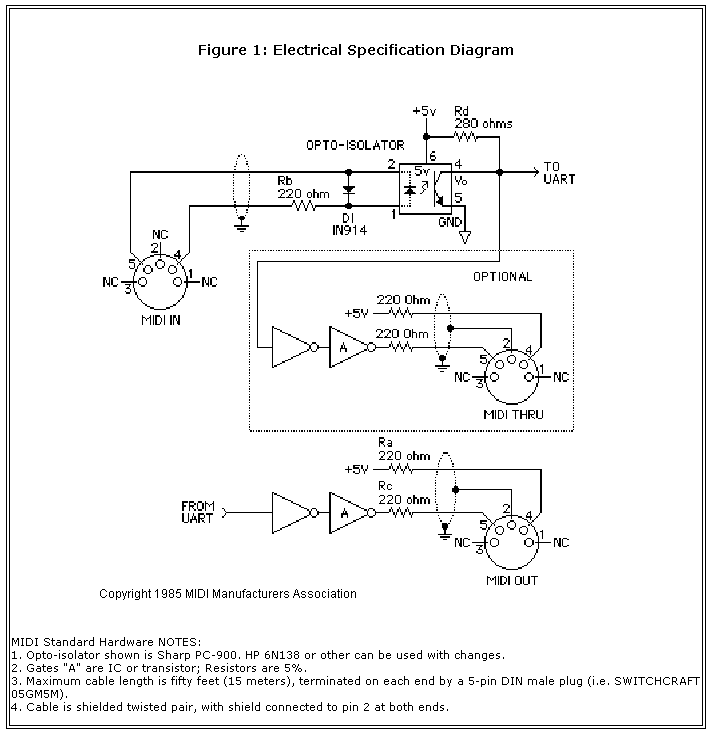Difference between revisions of "MIDI"
From CPCWiki - THE Amstrad CPC encyclopedia!
(→MIDI Interfaces for the CPC: DIY MIDI Interface from CPCinfos magazine) |
|||
| Line 30: | Line 30: | ||
* [[Mini Interface for connection to MK5 MIDI Keyboard]] | * [[Mini Interface for connection to MK5 MIDI Keyboard]] | ||
* [[DIY MIDI Interface from CPCAI magazine]] | * [[DIY MIDI Interface from CPCAI magazine]] | ||
| + | * [[DIY MIDI Interface from CPCinfos magazine]] by Thierry MANGION, port &FAF0 [http://cpcrulez.fr/hardware_montage_8x-interface_MIDI-part_2__CNFO.htm] | ||
== MIDI software for the CPC == | == MIDI software for the CPC == | ||
Revision as of 08:51, 8 August 2016
Musical Instrument Digital Interface (MIDI)
Contents
Software Protocol
Basically transmits commands like key on, key off, plus pitch/volume parameters.
Write more...
Hardware Protocol
The data is transferred at 31250 bits per second, using 8-N-1 format (one start bit, eight data bits, no parity bit, and one stop bit). So far, the MIDI protocol is much similar to RS232, and many MIDI interfaces do actually use standard "RS232" UART chips. Differences to RS232 are:
- The signals are transmitted as TTL levels (0V and 5V) (unlike +/-12V on RS232) with 5V reference voltage (unlike 0V on RS232)
- The receiver should pass the TTL signal through an Opto-Isolator
- The 31250 Hz baudrate isn't a standard RS232 rate
- MIDI is one-directional (MIDI OUT implements only TX, no RX, and MIDI IN implements only RX, no TX)
- There are no control signals like CTS/RTS/DSR/DTR used
Schematic
MIDI Interfaces for the CPC
- DHCP MIDI Interface (DHCP Electronics)
- EMR MIDI Interface (MIDI) (ElectroMusic Research)
- Music Machine (Sampling/Playback/MIDI) (RAM Electronics)
- Silicon Systems MIDI Interface
- Mini Interface for connection to MK5 MIDI Keyboard
- DIY MIDI Interface from CPCAI magazine
- DIY MIDI Interface from CPCinfos magazine by Thierry MANGION, port &FAF0 [1]
MIDI software for the CPC
- Foundation Multi-Track Step Time Sequencer (Foundation Software)
- EMR Miditrack Performer (ElectroMusic Research)
Presentation in ACU magazine
Amstrad Computer User reviews MIDI on CPC (page 1/3)
Amstrad Computer User reviews MIDI on CPC (page 2/3)
Amstrad Computer User reviews MIDI on CPC (page 3/3)
Presentation in CPCAI magazine
CPC Amstrad International 2/1987 reviews MIDI on CPC (pages 16-22)
DIY MIDI Interface from CPCAI
CPC Amstrad International 2/1987 published a DIY MIDI interface & software for CPC (pages 24-31)
Weblinks
- http://www.midi.org/ - MIDI Manufacturers Association (MMA)
- http://en.wikipedia.org/wiki/MIDI_1.0 - wikipedia on MIDI 1.0
- http://en.wikipedia.org/wiki/Musical_Instrument_Digital_Interface - wikipedia on MIDI in general



